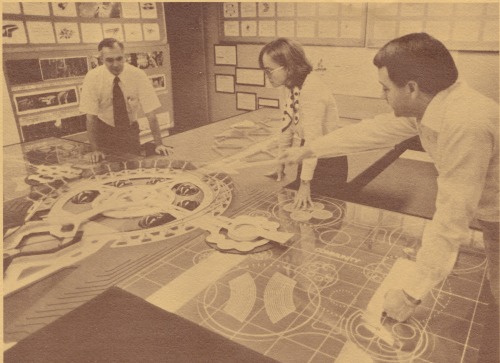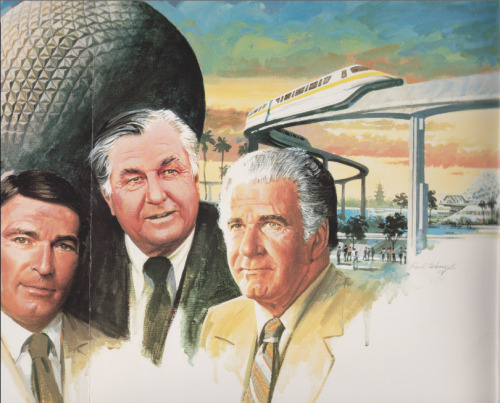epcotexplorer:On this day in 1975, Walt Disney Productions formally announced their plans to develop
epcotexplorer:On this day in 1975, Walt Disney Productions formally announced their plans to develop Walt Disney’s EPCOT City into a series of parks. Ultimately, these plans converged upon EPCOT Center, as it opened in 1982. These posts highlight the individual components of the first EPCOT Center parks and discuss the design and corporate process that lead to their creation. Enjoy! epcotexplorer:Explaining EPCOT: Master Planning and a Model Future EPCOT, 1976 – The black and white photo above gives us a rare, and perhaps long lost glimpse at a new vision for an early iteration of EPCOT Center. Why this version boasts incremental changes from concepts released previously to this deals directly with how and why EPCOT was explained to Disney’s audience and to those who would dream up and work on the monumental task that was building a new world of tomorrow, EPCOT Center.____________________By 1976 Disney was well on their way to finally acting upon the long lost notion of building EPCOT. However, Walt Disney’s idea for a working city of tomorrow’s industry and futurism was being remade into a park built for the grand purpose of exposition and corporate cooperation. EPCOT, as a park in 1976, was very similar to 1982’s final product in thematic spirit, but markedly different in execution. Each component of EPCOT would have been a separate entity in a series of EPCOT Satellites. So, in 1976, to explain this, Disney’s top executives began a campaign of awareness to interest sponsors and excite the general public that the already new and flourishing Walt Disney World was going to be expanding her thematic borders. Walt Disney Productions Chairman of the Board Donn Tatum and President E. Cardon Walker hosted a bevy of conferences and summits at the Contemporary Resort Hotel that focused on the aspects of EPCOT that would make it a lucrative project for sponsorship and fellowship. As previously discussed on this blog, Donn Tatum tackled the “EPCOT Future Technology Conference” that dealt with securing funding and support from leading companies and industries vital to EPCOT’s proposed thematic and cooperative purpose. Tatum explained that the EPCOT Theme Center was to be a forum of the future, a meeting place for industrial leaders and the public. Further, Disney described and intended EPCOT to be a venue designed for “information transfer”, as exhibition and WED’s brand of practical showmanship would be used to express sponsor’s products and concepts. As we all know, these ideas would propagate the final EPCOT Center product. Meanwhile, E. Cardon Walker was tasked with approaching a broader audience of commercial investors. In May and January of 1976, Walker spoke to the Urban Land Institute and the Florida Institute of Technology with the express purpose of showcasing that Walt Disney World was ready to build EPCOT as an expositional venue, with the help of industry leaders. Walker spoke at length of master planning and the techniques for construction and operation that ran Walt Disney World and that had already prepared the Vacation Kingdom to house and manage and run EPCOT efficiently. Spearheading this philosophy of experimental but efficient construction is Disney World’s EPCOT Building Code. The Reedy Creek Development District (Walt Disney World’s acting government) had already been using the code to guide phase 1 on Walt Disney World. Walker mentions that the EPCOT Building Code is a cornerstone of master planning and that it has been built with the future in mind:“ 1. [The EPCOT Building Code has the objectives of] accomplishing coordinated, balanced, and harmonious development in accordance of future and present needs.2. Provide flexibility that will encourage American industry to test, introduce, and demonstrate new ideas, materials, and systems emerging now and in the future.3. To provide an environment that will stimulate the best thinking in the creative development of new technologies to meet the needs of people.4. To insure the safety, health, and general welfare of the districts inhabitants, visitors, and premises.5. To establish a safe, sound, and forward-looking basis for developing and maintaining the district and its properties.6. To regulate the quality of materials and systems for all buildings and structures within the district, including their design, construction, occupancy, location, and maintenance. Therefore, it is seen that the guiding philosophy of the EPCOT Theme Satellites was already in motion, making a compelling case to center an entertainment venue on the same forward thinking drive and optimism. To convey Disney’s seriousness about their forthcoming foray into exposition, President Walker had a model on hand of the first satellite to be built in Walt Disney World: The EPCOT Theme Center. Readers of this blog are familiar with the concept, but perhaps not with this conceptualization of it. As far as I can see, it is very similar to concepts previously discussed here, but unique. The round “Main Street” structure, planned to be CommuniCore lacks the structures “inside” the building, as seen below, but instead has a main thoroughfare through the building. This area, perhaps, is the EPCOT Theme Show, 1976’s Spaceship Earth. Focused on communication, the EPCOT Theme Show would have been an introduction into the world of EPCOT and shown guests the purpose of the theme center and topics on display in the surrounding pavilions. Essentially, this is EPCOT referencing itself and referencing its purpose. Speaking of pavilions, the structure itself is also similar to past concepts but unique to this model. The rounded building seems to boast the same buttresses and supports that Herbert Ryman’s World Showcase concept art also features. In addition to this, there’s a monorail track running around the contours of the building perhaps giving credence to WED’s Community Transport Division’s concept art featuring a new model of monorail circling a similar building. This photograph and the Community Transport Division’s concept art come from the same year, suggesting that they are linked to the same EPCOT Satellite Project. The other pavilions on the model above reveal a bit of the murky conceptual past of the main component parts to EPCOT’s first version of Future World. To the viewer’s right, we can see the Community Pavilion, a broad swath of structures and ancillary buildings. The Community Pavilion would have focused on some of the more abstract subjects in EPCOT. Government, education, and the arts all would have found a home here, making them, perhaps, the more serious ancestors of EPCOT Center’s Journey into Imagination pavilion that focused on the arts, imagery and the creative optimistic spirit that was embodied in EPCOT. But, in 1976, Card Walker intoned that EPCOT’s Community Pavilion was for the purposes of“focusing our attention on new technologies, where we will want EPCOT to provide an “ongoing forum of the future” for the best creative thinking of industry, government, and academia is exchanged regarding practical solutions to the real needs of mankind.”Walker then goes on to say that“ [Walt Disney Productions] … has no intent to simply become another sponsor of seminars where the participants merely talk and dream. We are seeking those participants were both dreamers and doers, who are interested in getting innovative and far-reaching ideas transformed into reality. “ So, again, Card and Walt Disney Productions makes their intensions for EPCOT quite clear: EPCOT, while an exhibition, will be evolving, changing, and meeting the challenges of tomorrow. EPCOT’s dynamic purpose is change, but change that keeps it relevant an in touch with the innovative solutions required. EPCOT is explained as the “Communicator to the world, utilizing the growing spectrum of information transfer to bring new knowledge in the most effective ways to the world community. “Just as Card Walker is explaining his ideas for EPCOT, the photo of our 1976 EPCOT model is also explaining some of the other features of the new satellite theme park. Sitting directly behind the snappily dressed female imaginer (Who is she? Anyone know?! ) is a geometric structure that correlates to earlier images and renderings of the Future World of Energy Pavilion. Again, this isn’t the Universe of Energy that would come to grace Future World in 1982, but a rudimentary version of the pavilion. Concept art for the pavilion itself would have featured a heavily screen based walkthrough attraction utilizing lights and lasers. The shape of the building is also seen in the photograph with WED’s chief engineer John Zovich and former astronaut L. Gordon Cooper, now acting as WED’s Vice President and manager of the EPCOT Satellite project. This is a departure from 1975’s plans for the plot “north” of CommuniCore to house a “Science and Technology” pavilion perhaps indicating that Don Tatum had done his job well at securing sponsorships to solidify Energy as a main topic for a pavilion in the EPCOT Theme Center. The 1976 model is perhaps the last time this version of the EPCOT Theme Center was used until the concept evolved into EPCOT Center itself in 1977. More on that soon!Thus, this isn’t so much an essay concerning a model and how EPCOT was explained to the public, as it is a look at how EPCOT evolved over time. EPCOT’s trajectory from urban model of the future to a series of theme centers to a single unified park illustrates how difficult and multilateral the concept of EPCOT was for Disney to settle on and eventually get right. Card Walker and Don Tatum had a hugely daunting task at explaining how a city was going to become an entertainment and exhibition venue and be commercially successful for Walt Disney Productions and every sponsor involved. Given the amount of conceptual content that came pouring out of WED as EPCOT became a reality, this was truly a labor of love and one of the largest undertakings not only in Disney’s history, but in the history of themed entertainment. EPCOT was guided with not only the driving desire to fulfill Walt Disney’s final wishes, but a strongly defined sense of purpose and dynamic place in a rapidly approaching future.____________________________________ Notes:This essay is meant to be a companion piece to a much larger article on The EPCOT Theme Center (http://bit.ly/VCfkDY) that delves into how EPCOT City became EPCOT Center. While that article goes into detail on the actual process of molding the EPCOT concept into a working reality, this one, I hope should help shed new light on some of the details and incidentals of how this was actually done. Given that there’s a totally different model of The EPCOT Theme Center in this article, I am of the opinion that the project itself was constantly evolving, at least for the part of the park that became Future World. World Showcase has its own unique conceptual backstory and history, one, which will be written about, here, in the near future. The synthesis of Future World and World Showcase into one central park will also be a future article topic.Hope you enjoyed! -- source link
Tumblr Blog : epcotexplorer.tumblr.com




